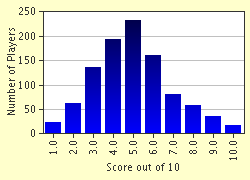Quiz Answer Key and Fun Facts
1. This word has several meanings; it describes certain designs or patterns which use interlacing lines and, in some cases, floral and animal motifs. It also describes a position in ballet in which the dancer stands "en pointe" on one foot and raises the other perpendicularly behind her. It can also describe a type of short, elaborate musical composition (especially for piano or other solo instrument) or a style of writing. It is of French origin, but is derived from the name of a prominent Middle Eastern country. Which is it?
2. This word describes someone who lives entirely for pleasure and is derived from the name of an ancient Greek city which was destroyed in 510 B.C. The city was famous for its luxury and opulence. Which word is it?
3. Which of these fabrics does NOT derive its name from a place or country?
4. Each of these paleontological/geological terms is derived from a place name. One of them, however, is something of a double eponym, since the place in question is itself named after a person; specifically, after a 17th century theologian, teacher, and hymnist who lived (and died) in the valley where a number of Stone-Age fossils were found.
5. A type of radioactive metallic element, a stately dance popular in the 18th - 19th centuries, and an elaborate overdress worn by fashionable ladies of the aristocracy in the 18th century all derive their name from this Eastern-European country.
6. This word describes a type of fabric, as well as a type of cat. It also forms part of the screen name of an eminent FT quizmaster. It derives from the name of a quarter in Baghdad.
7. If you are in a listless or depressed state, you are said to be in this area, which is in the ocean near the equator.
8. A crass, uncultured person preoccupied with material things and devoid of transcendental values may be called by this name, which derives from an ancient Middle-Eastern civilization.
9. Artemis, the Greek goddess of the moon (and of the hunt) was also called by this popular feminine name which derives from the mountain in Delos where, according to tradition, she was born.
10. One of these elements is named for a European country, another is named for a European city, a third is named for a group of European countries. Which one is NOT named after a place in Europe?
Source: Author
jouen58
This quiz was reviewed by FunTrivia editor
fringe before going online.
Any errors found in FunTrivia content are routinely corrected through our feedback system.

